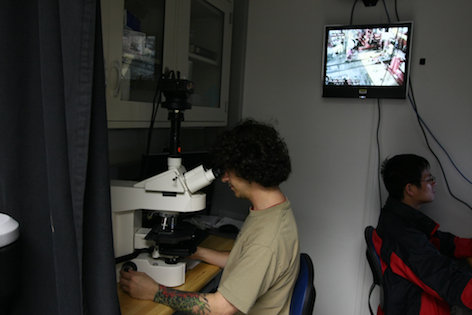
How do we know our samples are clean?
Obtaining clean samples from seafloor drilling can be a challenge- the drilling itself pumps massive amounts of surface seawater into the borehole as lubricant for the drilling machinery. This seawater contains lots of potentially contaminating microbes, such as phytoplankton (who have no place living in the dark subseafloor!), but there’s no way around using it. Luckily, there are ways of checking to see that your samples are not contaminated, and I discuss that here.
The last thing any microbiologist wants to do is spend two months on a ship collecting samples only to find out that they were contaminated. Therefore, we use a few different methods to check for this contamination. There are lots of microbes in surface seawater, which is part of the drill fluid constantly pumped into the borehole as we collect our drill cores. As much as I appreciate phytoplankton for making the oxygen that I breathe, I don’t want to find them in my samples! Or any of the other surface water microbes, either.
One thing I have been doing during Expedition 330 is deploying fluorescent microspheres into the drill fluid and then checking to see if they penetrate into the center of my rock samples. These microspheres are tiny (0.5 micrometers, or 1/2000th of a millimeter long- about the same size as a microbe) and fluoresce on their own. This makes them very handy as mimics for contaminating microbes. If we break a bag open in the core liner (the plastic tube that catches the core) that contains LOTS of microspheres, then we should be able to track if the microspheres stick to the sample or get inside of it. So every few cores, I deploy one of these bags with the core liner. It explodes inside the core liner (it is broken open by another part of the core which I wont discuss to keep this from turning into a novel), releasing the microspheres in the drill fluid. Here’s a photo of the exploded bag inside the core liner, just after core retrieval and before I take my sample.

When I get my sample back down to the lab, I always (for every sample, not just contamination testing) wash it 3X with sterile, filtered seawater to remove traces of drill fluid. For these contamination tests, I look for microspheres in each of these washes. I also look for it in the drill fluid, itself, which is caught in a beaker as the drill is being retrieved. Here’s a photo of that (it’s blurry because there’s a lot of movement as the rigfloor workers try to catch the drill fluid):

To look for the microspheres in the rocks, I collect samples from different parts of the rock- the outside and the center. For my own samples that I will do culturing and molecular biology with, I only take these from the center of the rock to avoid possible contamination on the outside from drilling fluid. I then take a bit of a slurry of rock and liquid preservative (formalin) and suck it down onto a filter, which i then mount on a microscope slide. Here’s my set-up:

You can see the sample in a tube, which I shake on the vortex machine (really fast to mix it up well), and then filter down using the filter tower (you put yor sample here- the vacuum pump sucks liquid through the filter, which sits right where that black clamp is holding the top and bottom parts of the filter tower together). I then count the microspheres using a fluorescence microscope, which is what I’m doing in the photo at the beginning of this blog. You can see in the background Li-Hui Chen, one of my fellow scientists on this cruise. He’s a geochemist from China, and one of the scientists who uses the ICP-AES that I discussed a few blogs ago. Li-Hui is a really friendly guy, I’m glad he’s on this cruise.
OK, so what do i see? Since I haven’t used any stains to dye the cells (this is what one does to quantify how many microbes are in a sample), the only thing that should appear under the fluorescent light emitted by the microscope are the fluorescent microspheres. And it works, here they are, at 630X magnification:

Those dots you see are micospheres that were in the drill fluid caught by the rig floor workers! Pretty cool. Theoretically, if the test works, I should see some microspheres in the drill fluid (because this is where they are released), fewer microspheres in the sterile seawater washes (because if any stick to the rocks, they should be removed with each successive wash), and none in the sample. So far, this is what I have found, which means my samples are clean. Hooray!
Another technique we use is to collect samples of the drill fluid itself (this can be done pretty easily on the ship) and then see what kinds of microbes are present in that sample. Since drill fluid is made from surface seawater, anything one sees in there shouldn’t be living below the bottom of the ocean, which is a very different environment. Therefore, if one sees the same organisms in their rocks and the drill fluid, then that sample was probably contaminated and is best ignored.
I hope this all made sense. It’s not the most exciting experiment we do out here, but it is one of the most important. Since I haven’t seen microspheres in my rocks, I can be reasonably sure they are safe for further analysis. Next time I’ll keep it lighter on the science and tell you a bit about shipboard life, but I promise it’s nothing that will be covered in the other blogs. Until then…